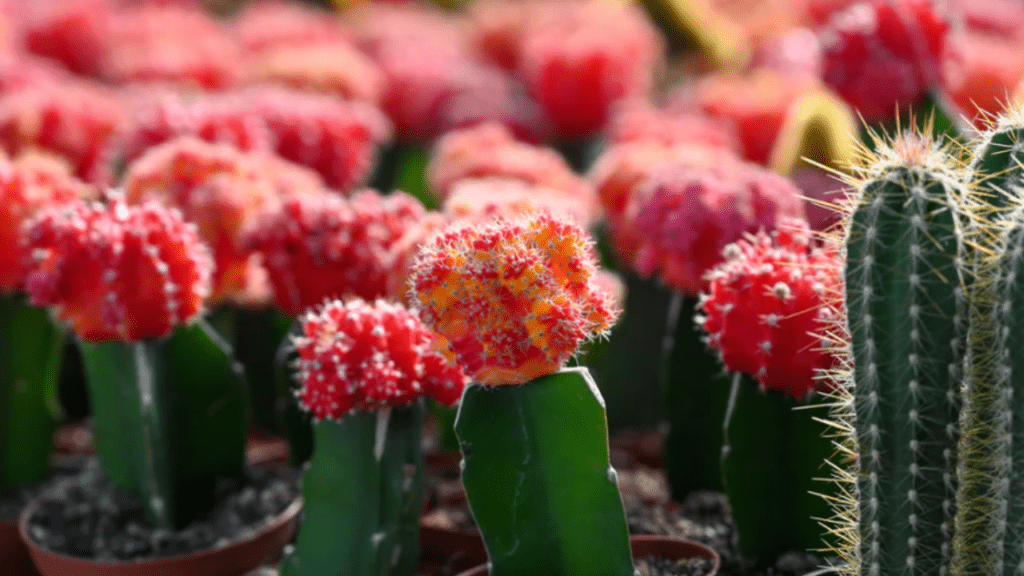
Growing a Moon Cactus Plant: A Complete Guide
Are you looking to grow a beautiful and unique moon cactus plant? Look no further! In this complete guide, we will walk you through the step-by-step process of successfully growing and caring for a moon cactus plant. From choosing the right soil and pot to understanding its watering and sunlight requirements, we’ve got you covered. Whether you’re a beginner or a seasoned plant enthusiast, this guide will help you ensure that your moon cactus plant thrives and adds a pop of color to your home or garden.
Table of Contents
ToggleWhat is a Moon Cactus Plant?
Description and characteristics
The moon cactus plant, also known as the grafted cactus or Gymnocalycium mihanovichii, is a unique and colorful plant that is popular among both beginner and experienced plant enthusiasts. It is actually a grafted combination of two different cactus species, with a colorful, ball-shaped top cactus grafted onto a green, spineless cactus base. The vibrant colors of the top cactus, which can range from bright pink to orange and yellow, make it a visually striking addition to any plant collection.
The moon cactus plant is relatively easy to care for and does well in bright, indirect light. It prefers well-draining soil and should be watered when the top inch of the soil feels dry. It is important to avoid overwatering, as the cactus is susceptible to root rot.
One unique characteristic of the moon cactus plant is its lack of chlorophyll, which means it cannot photosynthesize on its own. As a result, it relies on the green base cactus for nutrients and support. Despite this, the moon cactus plant is a hardy and low-maintenance plant that can thrive with the right care. Whether grown indoors or outdoors, the moon cactus plant is sure to add a splash of color and personality to any space.
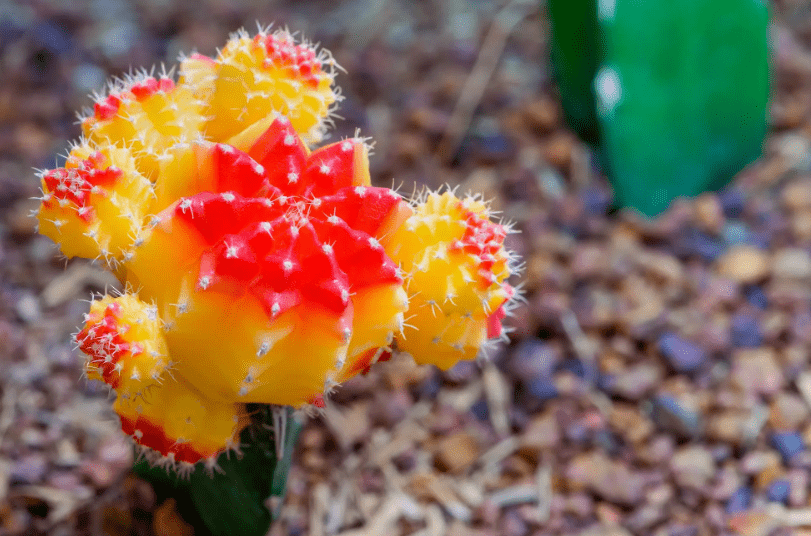
Origins and natural habitat
The moon cactus plant, also known as the Gymnocalycium mihanovichii, is native to South America. It is believed to originate from the mountainous regions of Argentina and Uruguay. In its natural habitat, the moon cactus plant thrives in dry, arid conditions with plenty of sunlight. It is often found growing among rocky areas and can tolerate high temperatures and minimal water. The plant has adapted to its environment by developing a water-storing stem to survive long periods of drought. This makes it a great addition to a desert or succulent garden. However, it is important to note that the moon cactus plant is not frost-tolerant and should be protected from freezing temperatures. Overall, the plant’s origins and natural habitat have influenced its care requirements, making it a low-maintenance and resilient plant for indoor and outdoor cultivation.
Different varieties and their distinct features
The moon cactus plant is a unique and interesting addition to any garden. With different varieties and distinct features, it is a great choice for succulent enthusiasts. The plant is often found in vibrant colors such as red, orange, and yellow, making it a striking addition to any garden. Some varieties of the moon cactus plant have a rounded, ball-like shape, while others have a more elongated appearance. Additionally, the plant’s spiky texture and unique growth patterns make it a standout choice for those looking to add visual interest to their garden. With its ability to thrive in arid conditions and its low-maintenance care requirements, the moon cactus plant is a great choice for both indoor and outdoor cultivation. Whether you are a seasoned succulent enthusiast or a beginner gardener, the moon cactus plant is sure to add a touch of color and interest to your garden.
Benefits of Growing a Moon Cactus Plant
Aesthetic appeal and color diversity
The moon cactus plant is a unique and interesting addition to any garden. With different varieties and distinct features, it is a great choice for succulent enthusiasts. The plant is often found in vibrant colors such as red, orange, and yellow, making it a striking addition to any garden. Some varieties of the moon cactus plant have a rounded, ball-like shape, while others have a more elongated appearance. Additionally, the plant’s spiky texture and unique growth patterns make it a standout choice for those looking to add visual interest to their garden. With its ability to thrive in arid conditions and its low-maintenance care requirements, the moon cactus plant is a great choice for both indoor and outdoor cultivation. Whether you are a seasoned succulent enthusiast or a beginner gardener, the moon cactus plant is sure to add a touch of color and interest to your garden.
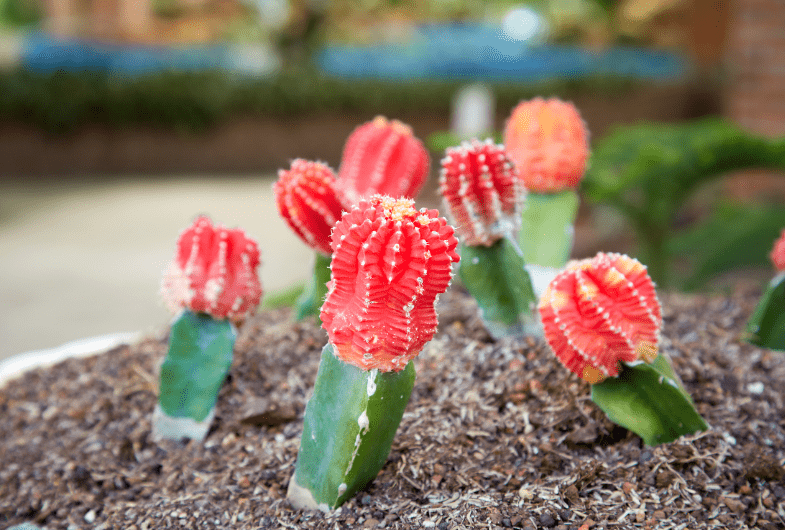
Low maintenance requirements
The moon cactus plant is a great choice for those who want a visually appealing addition to their garden without the hassle of high maintenance. These plants thrive in arid conditions and have low maintenance care requirements, making them a great choice for both indoor and outdoor cultivation. They don’t require frequent watering and can tolerate periods of drought, making them an easy and hassle-free plant to care for. With their striking colors and unique growth patterns, the moon cactus plant adds visual interest to any garden with minimal effort. Whether you are a seasoned succulent enthusiast or a beginner gardener, the moon cactus plant is a great choice for those looking for a low maintenance yet visually appealing plant to add to their collection.
Air purification qualities
Are another benefit of the moon cactus plant. Like other succulents, they have the ability to absorb carbon dioxide and release oxygen, which can help improve the air quality in your home or garden. This makes them a great choice for indoor cultivation, as they can help to purify the air and create a healthier living environment. In addition to adding visual interest to your space, the moon cactus plant can also contribute to a cleaner and more breathable atmosphere. With its low maintenance care requirements and air purification qualities, the moon cactus plant is a great choice for anyone looking to add a touch of color and health benefits to their home or garden.
How to Choose the Right Moon Cactus Plant
Tips for selecting healthy plants
When selecting a moon cactus plant, it’s important to choose a healthy one to ensure its long-term success in your garden or home. Look for plants with vibrant and colorful tops, as this indicates a healthy and thriving plant. Avoid plants with discolored, mushy, or sunken areas, as these may be signs of disease or improper care. Additionally, check for firm and plump stems, as this is a good indicator of a healthy plant. It’s also a good idea to inspect the roots of the plant to ensure they are plump and white, as this signifies a healthy root system. By following these tips, you can select a healthy moon cactus plant that will thrive in your space and provide visual interest and air purification qualities.
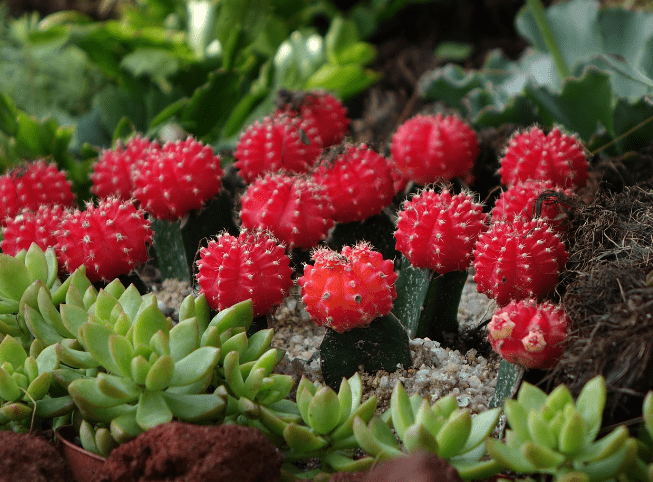
Understanding grafting and why it’s important
Grafting is an important technique used to combine the tissues of two plants to create a new plant with the desirable traits of both. This is commonly used in the horticultural industry to produce plants with specific characteristics such as disease resistance, improved fruit production, or unique aesthetics. Grafting allows for the propagation and production of plants that may not be easily propagated through traditional methods. It is important to understand grafting because it is a valuable tool for creating new plant varieties and improving overall plant health and productivity. By learning about grafting techniques, gardeners and horticulturists can expand their options for plant selection and create new and unique plant varieties.
Where to buy moon cactus plants
Moon cactus plants can be found at local nurseries, plant shops, and garden centers. They are also available for purchase online from various retailers. When purchasing a moon cactus plant, it’s important to choose a healthy and vibrant one. Look for a plant with bright and colorful stems and make sure the plant is free from any signs of damage or disease. It’s also a good idea to inspect the roots of the plant to ensure they are plump and white, as this signifies a healthy root system. By following these tips, you can select a healthy moon cactus plant that will thrive in your space and provide visual interest and air purification qualities.
Planting and Potting Moon Cactus
Best soil mix for moon cactus
Moon cactus plants require well-draining soil to prevent waterlogged roots. A good soil mix for moon cactus includes a combination of cactus or succulent potting mix and perlite or coarse sand. This will provide the proper drainage and aeration that the plant needs to thrive. It’s important to avoid using regular potting soil, as it retains too much moisture and can lead to root rot in cacti. When repotting or planting a moon cactus, make sure to choose a well-draining pot with drainage holes to further prevent water accumulation. By using the right soil mix and potting techniques, you can ensure that your moon cactus has the optimal growing conditions for healthy and vibrant growth.
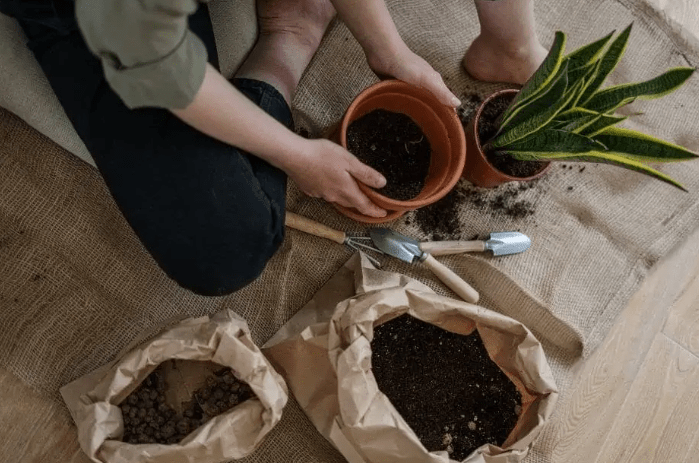
Choosing the right pot and drainage
Is crucial for the health and growth of your moon cactus plant. When selecting a pot for your moon cactus, it’s important to choose one with adequate drainage holes to prevent water from accumulating at the bottom. This will help to avoid root rot and other moisture-related issues. Additionally, be sure to choose a pot that is the right size for your moon cactus, allowing for a little extra space for growth but not so much that it becomes waterlogged. When it comes to choosing the right soil mix, opt for a well-draining combination of cactus or succulent potting mix and perlite or coarse sand. This will provide the proper drainage and aeration that the plant needs to thrive. Avoid using regular potting soil, as it retains too much moisture and can lead to root rot in cacti. By using the right pot and soil mix, you can provide your moon cactus with the optimal growing conditions for healthy and vibrant growth.
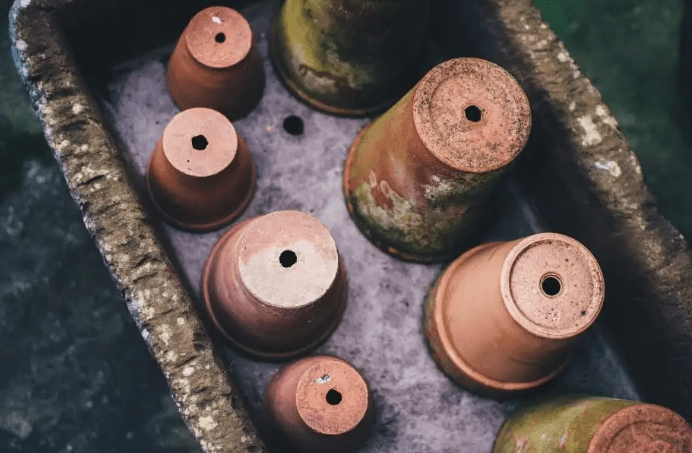
Step-by-step planting guide
- Choose a pot with adequate drainage holes to prevent water accumulation.
- Select a pot that is the right size for your moon cactus, allowing for some extra space for growth but not too much.
- Use a well-draining combination of cactus or succulent potting mix and perlite or coarse sand.
- Avoid using regular potting soil, as it retains too much moisture.
- Plant your moon cactus in the prepared pot and soil mix, ensuring that the roots are covered and the plant is secure.
- Place the pot in a location where the moon cactus will receive plenty of sunlight and warmth.
- Water the moon cactus sparingly, allowing the soil to dry out completely between waterings.
- Monitor the growth and health of your moon cactus, and make adjustments to its care as needed.
Care and Maintenance of Moon Cactus Plant
Watering schedule and techniques
When it comes to watering your moon cactus, it’s important to choose the right pot and soil mix. Make sure to use a well-draining combination of cactus or succulent potting mix and perlite or coarse sand. Regular potting soil retains too much moisture, so it’s best to avoid using it. Once you’ve planted your moon cactus, place it in a location where it will receive plenty of sunlight and warmth. When it comes to watering, it’s important to water the moon cactus sparingly and allow the soil to dry out completely between waterings. Keep an eye on the growth and health of your moon cactus and make adjustments to its care as needed. With the right watering schedule and techniques, your moon cactus will thrive and grow beautifully.
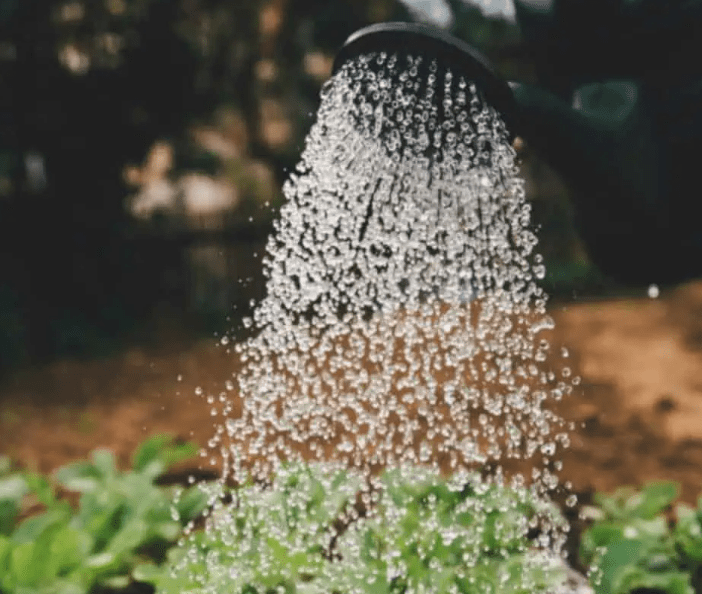
Light requirements and positioning
Are crucial for the care and maintenance of your moon cactus plant. Moon cacti thrive in bright, indirect sunlight, so it’s important to place them near a window where they can receive plenty of light. Avoid exposing them to direct sunlight, as this can cause sunburn and damage the plant. If you notice that your moon cactus is stretching or leaning towards the light, it’s a sign that it’s not receiving enough sunlight and you should consider moving it to a brighter location.
In terms of positioning, it’s important to keep your moon cactus in a warm and well-ventilated area. Avoid placing them in drafty or cold spots, as they prefer temperatures between 70-80 degrees Fahrenheit. Additionally, make sure to rotate your moon cactus occasionally to ensure even growth and prevent it from leaning towards one direction.
By paying attention to the light requirements and positioning of your moon cactus, you can ensure that it receives the optimal conditions for healthy growth and vibrant colors. With the right care and maintenance, your moon cactus will continue to thrive and bring beauty to your home.
Temperature and humidity considerations
Are important factors to keep in mind when caring for your plants, especially moon cacti. It’s important to avoid exposing them to direct sunlight, as this can cause sunburn and damage the plant. If you notice that your moon cactus is stretching or leaning towards the light, it’s a sign that it’s not receiving enough sunlight and you should consider moving it to a brighter location. In terms of positioning, it’s important to keep your moon cactus in a warm and well-ventilated area. Avoid placing them in drafty or cold spots, as they prefer temperatures between 70-80 degrees Fahrenheit. Additionally, make sure to rotate your moon cactus occasionally to ensure even growth and prevent it from leaning towards one direction. By paying attention to the light requirements and positioning of your moon cactus, you can ensure that it receives the optimal conditions for healthy growth and vibrant colors. With the right care and maintenance, your moon cactus will continue to thrive and bring beauty to your home.
Fertilizing tips for optimal growth
When it comes to fertilizing your plants for optimal growth, it’s important to choose a high-quality, well-balanced fertilizer specifically formulated for cacti and succulents. Look for a fertilizer with a low nitrogen content to prevent excessive growth and elongation of the plant. During the growing season in spring and summer, fertilize your moon cactus every 4-6 weeks. However, reduce the frequency to every 8-12 weeks during the dormant season in fall and winter. Be sure to dilute the fertilizer to half the recommended strength to avoid overfeeding and burning the roots. When applying the fertilizer, water your moon cactus first to moisten the soil and then apply the fertilizer. This will help prevent the roots from becoming damaged. Remember to always follow the instructions on the fertilizer label and adjust the frequency and strength of fertilization based on the specific needs of your moon cactus. With proper fertilizing and care, your moon cactus will thrive and display vibrant, healthy growth.
Common Problems and Solutions
Identifying and treating common pests
Is essential for the health and well-being of your plants. Some common pests that can affect your plants include aphids, mealybugs, and spider mites. To identify these pests, look for tiny insects or white, cottony masses on the stems and leaves of your plants. If you notice any of these signs, it’s important to take action to control and eliminate the pests.
One way to treat common pests is to use insecticidal soap or neem oil. These natural remedies can help to effectively control pests without harming the plant. You can also use a soft brush or cloth to physically remove the pests from the plant.
In addition to pests, it’s important to watch out for signs of disease in your plants. Common plant diseases include powdery mildew, root rot, and fungal infections. To prevent and treat these diseases, it’s important to maintain good airflow around your plants and avoid overwatering.
Regularly inspecting your plants for pests and diseases is key to preventing and treating these issues. By staying vigilant and taking proactive measures, you can help to keep your plants healthy and thriving.
Handling diseases and fungal issues
In your plants requires proactive care and attention. Natural remedies such as neem oil, insecticidal soaps, and garlic spray can help to effectively control pests without harming the plant. You can also use a soft brush or cloth to physically remove the pests from the plant. In addition to pests, it’s important to watch out for signs of disease in your plants. Common plant diseases include powdery mildew, root rot, and fungal infections. To prevent and treat these diseases, it’s important to maintain good airflow around your plants and avoid overwatering. Regularly inspecting your plants for pests and diseases is key to preventing and treating these issues. By staying vigilant and taking proactive measures, you can help to keep your plants healthy and thriving.
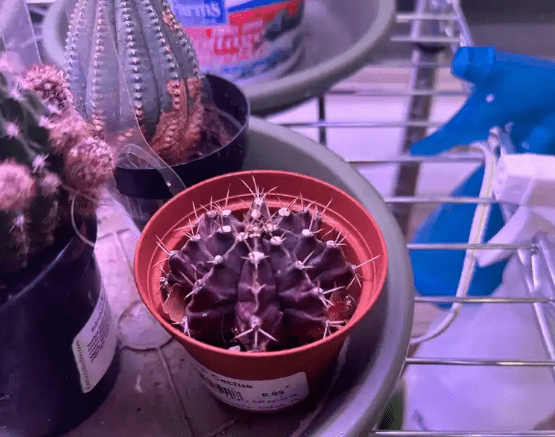
Tips for preventing and managing overwatering
Overwatering can be detrimental to your plants and lead to root rot, mold, and other issues. To prevent overwatering, it’s important to choose the right type of soil for your plants and ensure good drainage. Using a moisture meter can also help you determine when your plants actually need watering. Another tip is to water your plants in the morning to allow any excess water to evaporate throughout the day. If you suspect that your plants are being overwatered, it’s important to take action quickly. You can try using a fan to improve air circulation around your plants and allow the soil to dry out. Additionally, you can gently loosen the soil to promote better drainage. Remember to always monitor your plants and adjust your watering routine as needed to prevent overwatering.
Propagation Techniques for Moon Cactus Plant
Step-by-step guide to propagating moon cactus
- Select a healthy, mature moon cactus plant to use for propagation.
- Use a sharp, sterile knife to carefully cut off a healthy, mature stem from the parent plant. Make a clean cut to ensure successful propagation.
- Allow the cut end of the stem to dry and callous over for a few days to prevent rotting.
- Once the cut end has calloused over, plant the stem in a well-draining cactus mix or sandy soil. Water the soil lightly and place the cutting in a warm, bright location to encourage root development.
- Monitor the cutting regularly and water sparingly to avoid overwatering. Once roots have developed, you can gradually increase the amount of water given to the new plant.
- After the new plant has established roots and is growing well, you can continue to care for it as you would a mature moon cactus plant.
By following these step-by-step propagation techniques, you can successfully propagate moon cactus plants and expand your collection of these unique and colorful succulents.
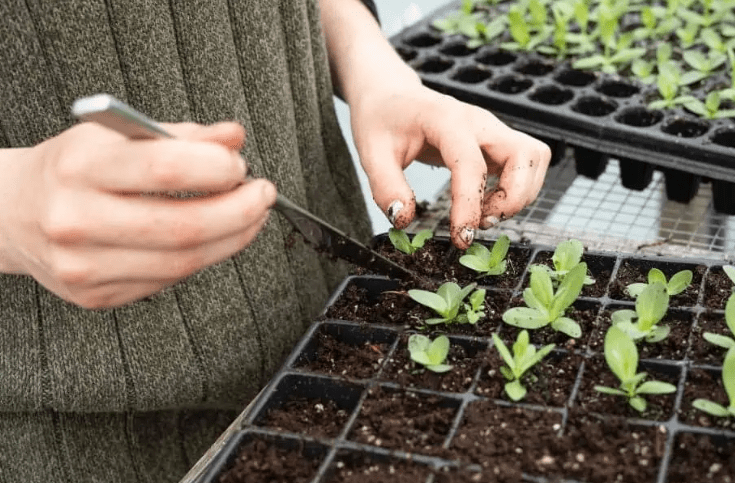
Tools and materials needed
For propagating moon cactus plants include a sharp, clean knife or pair of scissors for cutting the stem, a well-draining cactus mix or sandy soil for planting the cutting, and a suitable container for the new plant. You’ll also need access to a warm, bright location for encouraging root development and regular monitoring of the cutting to ensure it’s growing well. Additionally, it’s important to water the soil lightly and sparingly to avoid overwatering and allow the cutting to fully establish roots. With these tools and materials and proper care, you can successfully propagate moon cactus plants and expand your collection of these unique and colorful succulents.
Creative Display Ideas for Moon Cactus Plant
Moon cactus plants are unique and colorful succulents that can make a beautiful addition to any indoor or outdoor space. When it comes to displaying your moon cactus plant, there are plenty of creative ideas to consider. One popular option is to plant your moon cactus in a decorative pot or planter that complements its vibrant colors. You can also consider creating a mini garden display by grouping several moon cactus plants together in a shallow dish or tray. Another creative idea is to hang your moon cactus plant in a macramé or decorative hanging planter to add a touch of greenery to your space. You can also consider displaying your moon cactus on a windowsill, shelf, or desk to add a pop of color to any room. No matter how you choose to display your moon cactus plant, be sure to place it in a location with bright, indirect sunlight and well-draining soil to ensure its continued growth and vibrancy. By incorporating these creative display ideas, you can showcase the beauty of your moon cactus plant in a way that enhances any space.
In conclusion, growing a moon cactus plant can be a rewarding experience if you follow the right steps and provide the proper care. It’s important to choose the right soil, pot, and provide the necessary sunlight and water for the plant to thrive. With the right care and attention, your moon cactus plant can become a beautiful addition to your home or garden. Remember to regularly check for any signs of distress or disease and take appropriate action to ensure the health and longevity of your plant.
Frequently asked questions And Answer
Moon cactus plants need plenty of bright, indirect sunlight. It’s best to place them near a window where they can get a few hours of sunlight each day.
It’s important not to overwater a moon cactus plant. Water it sparingly, allowing the soil to dry out slightly between waterings. Typically, once every 1-2 weeks is sufficient.
.
Moon cactus plants are best suited for indoor environments or outdoor areas with mild temperatures. They are not frost-tolerant and should be brought indoors during colder months.
A well-draining cactus or succulent mix is ideal for moon cactus plants. This type of soil will prevent water from pooling around the roots and causing rot.
Moon cactus plants can benefit from a diluted, balanced fertilizer during the growing season (spring and summer). Fertilize once a month to encourage healthy growth.
Moon cactus plants can be propagated by carefully removing offsets or “pups” that grow at the base of the plant. Allow the offsets to dry for a day or two before planting them in their own pots.
Spider mites and mealybugs are common pests that may affect moon cactus plants. To prevent infestations, regularly inspect the plant and treat any pests promptly.
With proper care, moon cactus plants can live for several years. However, they are grafted plants and may eventually outgrow their rootstock, leading to a decline in health. It’s best to enjoy them while they are thriving and replace them as needed.
